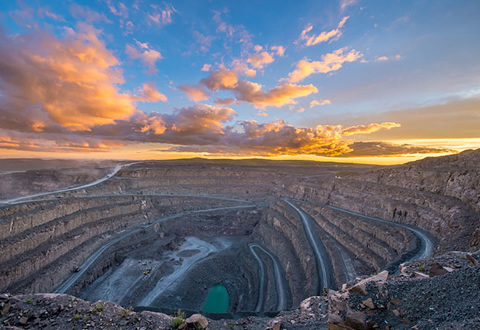

Indicator
Minerals

Kao Mine Indicator Minerals
Minerals contained in the surrounding area give our geologists clues as to where diamond deposits may have formed. They are minerals that are characteristic of kimberlite but usually more abundant than diamonds (and therefore easier to find). By tracing these indicators, the source of the kimberlite, and potential diamond deposits may also be found.
The indicator minerals are also often by products of diamond mining and offer a potentially lucrative opportunity to processing companies. The main by-products of our KAO diamond mining is Olivine, Chrome Dioxide, Garnets and Ilmenite.
 Business Opportunity
Business Opportunity
There is much potential for turning the mine indicator minerals/by-products into an exciting viable business. Should you be interested in this and would like some more information on this opportunity, please contact us:
info@stormmountaindiamonds.com
Olivine
The mineral olivine is a magnesium iron silicate with the formula (Mg²⁺, Fe²⁺)₂ SiO₄. Thus it is a type of nesosilicate or orthosilicate. The primary component of the earth's upper mantle, it is a common mineral in Earth's subsurface but weathers quickly on the surface.
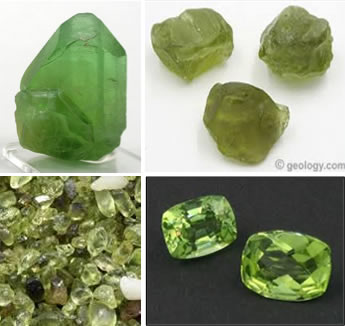
Chrome Diopside
Diopside has been regarded only as a collector's gemstone until recently, when the deep forest-green Chrome Diopside variety has made its way into the mainstream gemstone market.
Gemstone quality diopside is found in two forms: the black star diopside and the chrome diopside (which includes chromium, giving it a rich green color). At 5.5–6.5 on the Mohs scale, chrome diopside is relatively soft to scratch. Due to the deep green color of the gem, they are sometimes referred to as Siberian emeralds, though they are on a mineralogical level completely unrelated, emerald being a precious stone and diopside being a semi-precious stone.
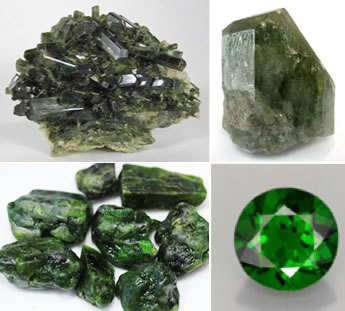
| Chemical Composition | ((Ca,Na,Mg,Fe,Cr)2(Si,Al)2O6) |
| Mohs scale hardness | 6 |
| Vickers Hardness | 7.7 GPa at a load of 0.98 N |
| Specific Gravity | 3.25 to 3.55 |
| Crystal habit | Massive to granular |
| Optical angle | 58° to 63° |
| Indices of Refraction | nα=1.663–1.699, nβ=1.671–1.705, and nγ=1.693–1.728 |
| Color | is transparent to translucent deep green |
Garnets
Garnet is the name used for a large group of rock-forming minerals.
These minerals share a common crystal structure but differ in chemical composition.
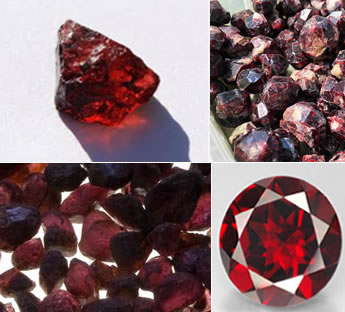
| Chemical Composition | X3Y2(SiO4)3 , however "X" can be Ca, Mg, Fe2+ or Mn2+, and "Y" can be Al, Fe3+, Mn3+, V3+ or Cr3+ |
| Mohs scale hardness | 6.5–7.5 |
| Vickers Hardness | 7.7 GPa at a load of 0.98 N |
| Optical Properties | Single refractive, often anomalous double refractive |
| Crystal habit | Rhombic dodecahedron or cubic |
| Crystal System | Isometric |
| Specific Gravity | 3.25 to 3.55 |
| Crystal habit | Massive to granular |
| Optical angle | 58° to 63° |
| Indices of Refraction | nα=1.663–1.699, nβ=1.671–1.705, and nγ=1.693–1.728 |
| Color | Various: red, orange, yellow, green, blue, purple, pink, brown, black and colourless, with reddish shades most common |
Ilmenite
Ilmenite is used to produce titanium metal. Some ilmenite is also used to produce synthetic rutile, a form of titanium dioxide used to produce white, highly reflective pigments.
A unique line of hi-end 24-carat jewelry titled the “Heaven on Earth Collection,” was recently created exclusively by Shefa Gems Ltd., featuring Ilenite stones operating in Israel, and world-renowned, Israeliborn jewelry designer Yossi Harari.
www.shefagems.com/heaven-on-earth-collection-items
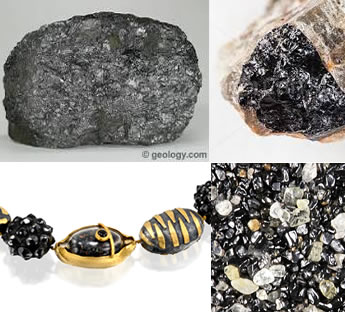
| Chemical Composition | Titanium-iron oxide FeTiO |
| Mohs scale hardness | 5-6 |
| Optical properties | Uniaxial (–) |
| Crystal habit | GGranular to massive and lamellar exsolutions in hematite or magnetite |
| Crystal system | Rhombohedral (3); H-M symbol: (3) |
| Specific gravity | 4.70–4.79 |
| Fracture | Conchoidal to subconchoidal |
| Color | Iron-black; gray with a brownish tint in reflected light |
